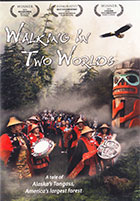
Walking in Two Worlds 2014
Distributed by The Video Project, PO Box 411376, San Francisco, CA 94141-1376; 800-475-2638
Produced by Bo Bourdart & Wanda Culp
Directed by Bo Boudart
DVD , color, 62 min.
Sr. High - General Adult
Activism, Ecology, Environmental Justice, Environmentalism, Indigenous Peoples, Industries, Native Americans, Native Peoples, Natural Resources, Wildlife Conservation
Date Entered: 04/07/2015
Reviewed by Jennifer Loft, Ph.D. student in Global Gender Studies, Department of Transnational Studies, University at BuffaloWalking in Two Worlds documents the struggles of the Tlingit/Haida nations in Alaska to negotiate a more contemporary method of colonization: the destruction of the forests and wildlife in the final frontier. The film highlights the tensions between those Tlingit/Haida who want to save the land from further destruction and those who have helped the logging corporations and made economic prestige a higher priority. Walking in Two Worlds forces viewers to consider the meanings behind the traditional, the contemporary, the desire for economic progress, and the act of “selling out” to globalized capitalism.
The greatest strength of this film is the use of exquisitely beautiful shots of the landscape and wildlife in Alaska. This technique allows the viewers to acknowledge how the logging corporations create employment and economic opportunities for the Indigenous nations in Alaska, while also being critical of the costs of such opportunities and what may very well be lost forever. The producers of this film also provide viewers with a glimpse of what it means to be Tlingit/Haida, through an exploration of their social structures and traditional ways of subsistence. The Tlingit/Haida are the forest because of the foods they eat and their relationship with the natural world. Logging corporations are not only destroying the forest, but the entire identity of a people.
Walking in Two Worlds is exceptional viewing for wildlife activists, contemporary American historians, high school and college students, and humanitarians. I highly recommend this film to anyone who has an interest in learning how American and global capitalism are slowly, yet surely, gravely debilitating both the natural world and our human species that relies on that world. If we do not take action now to preserve what is left of our wildlife, it will not be here for our children and grandchildren to enjoy.
Awards
- Winner, 2014 Moondance International Film Festival
- Winner, 2014 Chagrin Documentary Film Festival